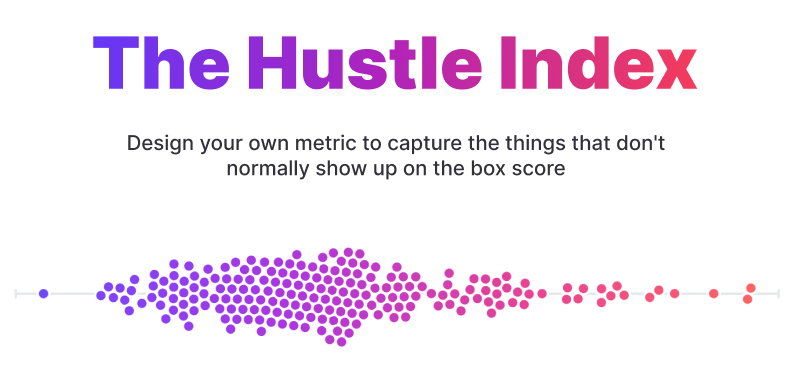
You can select a player from the dropdown, click on them in the table, or click on any of the charts on the bottom to get a clearer picture of any player's hustle stats. Hovering over the player on the charts will show tooltips revealing more information.
How is the Hustle Index calculated?
The Hustle Index for a player comes from calculating the z-score for each component metric, multiplying them by the selected weights, summing them all together, and then normalizing that number such that the highest score is 100. Note that we are not treating this as a definitive methodology or statistic, but instead something that's fun to play around with!Create Your Hustle Index
Whose Line is Grit, Anyway?
It's clear from watching basketball that some players impact games in ways that go beyond a traditional box score. Celtics coach Brad Stevens eloquently described his philosophy on players that do "the little things" well:
When considering the consequences of not doing the little things, you realize there are no little things.
Brad Stevens
Luckily, the age of advanced player tracking allows us to quantify things that have historically been thrown into an "intangibles" category.
We wanted to build a tool to let you explore this data. We also tried a few iterations of coming up with a general Hustle Index: a single metric that captures how well a player does "the little things." It was a lot of fun experimenting with the formula, particularly around coming up with the right balance so that you could compare quick guards, versatile wings, and imposing bigs to each other in a meaningful way. We decided to interactively include that process as part of this analysis, so you can try coming up with your own metric!
These are the different component metrics we decided to incorporate into the Hustle Index:
- Average speed - Average speed in miles per hour
- Box outs - Establishing better rebounding position for the player or their teammates
- Charges drawn - Resulting in an offensive foul and change of possession
- Contested 2pt shots - Challenging a 2pt field goal attempt
- Contested 3pt shots - Challenging a 3pt field goal attempt
- Deflections - Typically during a pass between offensive teammates
- Distance traveled - Distance traveled in miles
- Loose balls recovered - Recovered either on offense or defense
- Screen assist pts - The number of points scored as a result of a screen a player set
We're just getting started.
Subscribe for more thoughtful, data-driven explorations.